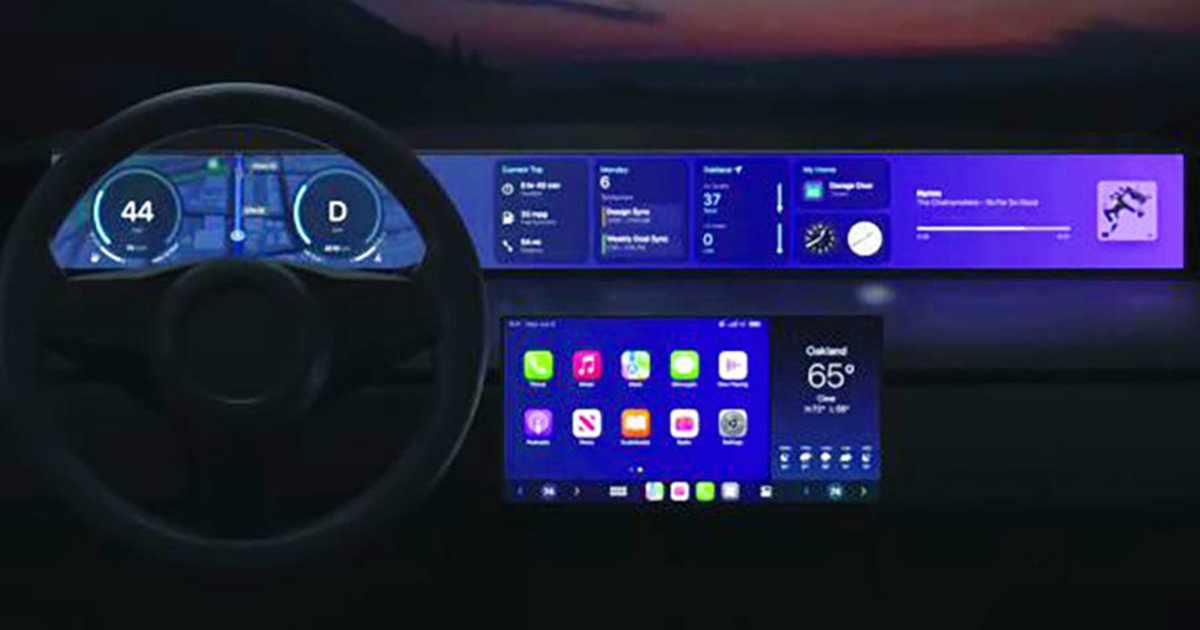
Apple’s new version of CarPlay is designed to take over every screen on the dashboard, replacing user interfaces and controls while gaining access to crucial vehicle and driver data. It’s likely to launch a turf war with automakers reluctant to give up such valuable real estate.
Where drivers view extending iPhone functions into the dashboard as a matter of convenience, automakers and tech companies see a big dollar battleground. McKinsey & Co. estimates vehicle data will be worth up to $400 billion annually by 2030. Fortune Business Insights predicts the global connected-car market will grow from nearly $60 billion in 2021 to more than $190 billion in 2028.
As cars have become more connected, automakers envision vehicle data as an essential and profitable component of their future business plans. They want to sell services such as pay-per-mile insurance and route-based offers from retailers.
“At stake is the search experience in cars, which are essentially browsers on wheels,” said Roger Lanctot, Strategy Analytics’ director of automotive connected mobility.
Only the smallest and newest automakers will be willing to surrender their dashboard/in-vehicle experiences to Apple, he said.
Yet Apple said it was “working with automakers around the world” when it introduced the new version of CarPlay at its annual Worldwide Developer Conference in June. The tech giant displayed 14 major car company logos including major brands such as Ford, Mercedes-Benz and Honda. It said the new version will be available in vehicles starting late next year.
Automakers contacted by Automotive News declined to say how they would incorporate the new CarPlay version.
General Motors has “no concrete plans to share yet how we’re approaching what Apple showed earlier this summer,” said spokesman Stu Fowle.
“We evaluate all potentially relevant new technologies and functions internally,” said Andrew Brudnicki, a Mercedes-Benz USA spokesman. “In this context, we also hold discussions with Apple.”
“Unfortunately, we cannot comment on future product plans,” said Miles Johnson, a Hyundai Motor America spokesman.
When Apple introduced CarPlay in 2014, several German automakers including Audi, Mercedes-Benz and Volkswagen expressed concerns about losing infotainment data such as navigation search. Toyota resisted adding CarPlay and Android Auto, which provides a similar capability for Google’s Android devices, until 2018.
Because CarPlay is uniform across all vehicles, automakers relinquish brand differentiation on in-dash displays to Apple and Google. In its current iteration, automakers restrict CarPlay to a vehicle’s center-dash display and allow it to duplicate iPhone apps for calls, messages and navigation. The system includes third-party apps, including Waze, Spotify, ChargePoint and others. Drivers control the apps via a car’s touchscreen and voice control.
The latest version of CarPlay reaches even deeper into the dashboard and “communicates with your vehicle’s real-time systems,” Emily Schubert, Apple’s senior manager for car experience engineering, said at the Worldwide Developer Conference.
The preview showed how CarPlay could replace an automaker’s instrument panel displays for speedometer, tachometer, temperature gauges and fuel or EV battery level. It also allows customizing an instrument panel using Apple-curated layouts, colors, backgrounds and dials.
And it can add customizable widgets to car displays that show calendar items, weather information, address book contacts and more from a connected iPhone.
Given their long product lead times, automakers would need to start implementing the new version of CarPlay soon. But Rob Passaro, an automotive technology and product management consultant who worked closely with Apple while at BMW, said he hasn’t heard of any automakers proceeding with its implementation since the announcement.
Still, Apple’s vast popularity among consumers gives it significant leverage over automakers. Buyers now see CarPlay as standard equipment, said Brian Moody, executive editor at Cox Automotive’s Autotrader.
According to Schubert, 98 percent of new vehicles now come with CarPlay and 79 percent of buyers “only consider CarPlay-capable vehicles” when shopping for new cars.
“Trying to boot CarPlay at this point is a pretty big risk,” said Mike Ramsey, a Gartner automotive and smart mobility analyst.
Since debuting CarPlay at the Geneva Motor Show eight years ago, Apple has periodically improved it with new user interfaces, apps and features. In an update last year, CarPlay gained features such as showing EV charging stations along a route and adding optional color schemes.
The new version would be the most significant update and comes as Google and Amazon also make inroads into the vehicle.
“Apple, Google and Amazon are desperate to own the emerging connected car,” Lanctot said.
CarPlay and Google’s Android Auto have made automakers’ infotainment systems largely obsolete for many consumers.
“There’s no question that Apple and Google have won the user experience war,” Ramsey said.
“CarPlay and Android Auto aren’t flawless,” he said. “But they work a lot better than [automakers’] embedded systems for key things like mapping and accessing applications for music, podcasts and audio books.”
Apple rival Google has already moved deeper into the dashboard with its Android Automotive Operating System (not to be confused with Android Auto). Automakers such as General Motors, Volvo/Polestar, Renault, Nissan and Mitsubishi have cars with Android Automotive on board.
Android Automotive is powering infotainment functions, instrument clusters and other displays, said Andrew Poliak, chief technical officer for Panasonic Automotive Systems.
But Android Automotive is different than the current CarPlay because it is an automotive operating system such as QNX or Linux and allows automakers more control, Poliak said.
“Automakers are able to build their own systems using Android Automotive OS and restrict or allow anything to run on it,” Poliak said.
Apple CarPlay currently runs on Google’s Android Automotive OS in several vehicles, Poliak said. This kind of compatibility likely will not be the case with the next version of CarPlay given Apple’s walled-garden approach to its technology.
“Google has taken many steps to improve its transparency and make clear its automotive roadmap,” Lanctot said.
“Apple is worse than Google when it comes to inflexibility,” said Lanctot. “But Apple will no doubt tell automakers that their customers are clamoring for an Apple-like experience in their cars.”